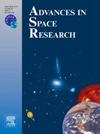Indian Network for Space Weather Impact Monitoring (InSWIM): An initiative to observe and model the low latitude ionosphere over the Indian longitudes
IF 2.8
3区 地球科学
Q2 ASTRONOMY & ASTROPHYSICS
引用次数: 0
Abstract
The Space Physics Laboratory (SPL) of Vikram Sarabhai Space Centre (VSSC) has launched a science program called the Indian network for Space Weather Impact Monitoring (InSWIM) to monitor the effects of Space Weather events on the Indian low-latitude ionosphere-thermosphere system. This program aims to study the impact of Space weather on the Indian ionospheric region and develop an Ionospheric Model. The InSWIM network stations will be equipped with instruments such as Global Navigation Satellite Systems (GNSS) receivers, Low Earth Orbit (LEO) receivers, ionosondes, magnetometers, and airglow photometers/imagers. Currently, multi-frequency, multi-constellation GNSS Receiver systems are operational at various stations in India. This network will enable us to understand (a) the quiet-time variability of the ionosphere over the Indian low-latitude region, (b) comprehensively study the response of the low-latitude ionosphere specific to the Indian longitudes under different space weather conditions, with the goal of understanding the various physical mechanisms causing variability in the ionospheric regions, and (c) develop an ionospheric model to reduce ionospheric errors in GNSS systems. Additionally, this network will provide complementary information for rocket and satellite-based experiments. This paper aims to provide details of the InSWIM network to the scientific community for its possible use in monitoring and studying the impact of space weather on the near-Earth space environment.
印度空间天气影响监测网络(InSWIM):一项在印度经度上观测和模拟低纬度电离层的倡议
Vikram Sarabhai空间中心(VSSC)的空间物理实验室(SPL)启动了一项名为印度空间天气影响监测网络(InSWIM)的科学计划,以监测空间天气事件对印度低纬度电离层-热层系统的影响。该项目旨在研究空间天气对印度电离层区域的影响,并开发电离层模型。InSWIM网络站点将配备诸如全球导航卫星系统(GNSS)接收器、低地球轨道(LEO)接收器、电离层探空仪、磁力计和气辉光度计/成像仪等仪器。目前,多频率、多星座GNSS接收机系统在印度的多个站点运行。该网络将使我们能够了解(a)印度低纬度地区电离层的静时变率,(b)全面研究不同空间天气条件下印度经度对低纬度电离层的响应,以了解导致电离层区域变率的各种物理机制,以及(c)开发电离层模型以减少GNSS系统中的电离层误差。此外,该网络将为火箭和卫星实验提供补充信息。本文旨在向科学界提供InSWIM网络的详细信息,以便其可能用于监测和研究空间天气对近地空间环境的影响。
本文章由计算机程序翻译,如有差异,请以英文原文为准。
求助全文
约1分钟内获得全文
求助全文
来源期刊

Advances in Space Research
地学天文-地球科学综合
CiteScore
5.20
自引率
11.50%
发文量
800
审稿时长
5.8 months
期刊介绍:
The COSPAR publication Advances in Space Research (ASR) is an open journal covering all areas of space research including: space studies of the Earth''s surface, meteorology, climate, the Earth-Moon system, planets and small bodies of the solar system, upper atmospheres, ionospheres and magnetospheres of the Earth and planets including reference atmospheres, space plasmas in the solar system, astrophysics from space, materials sciences in space, fundamental physics in space, space debris, space weather, Earth observations of space phenomena, etc.
NB: Please note that manuscripts related to life sciences as related to space are no more accepted for submission to Advances in Space Research. Such manuscripts should now be submitted to the new COSPAR Journal Life Sciences in Space Research (LSSR).
All submissions are reviewed by two scientists in the field. COSPAR is an interdisciplinary scientific organization concerned with the progress of space research on an international scale. Operating under the rules of ICSU, COSPAR ignores political considerations and considers all questions solely from the scientific viewpoint.
 求助内容:
求助内容: 应助结果提醒方式:
应助结果提醒方式:


